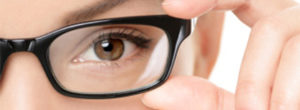Lenses are the “window” to great vision and a good-looking pair of eye glasses. Lens designs include single-vision, aspheric, flat top (lined bifocials), progressives (no-line bifocials) and tri-focals as well as polarized sunglasses. Today’s Vision eye doctors also typically recommend optional lens treatments for your vision and durability of your eyewear. These include scratch protection coating, UV protection (blue light) and anti-reflectives.
There are many makers of lenses, but Today’s Vision primarily utilizes the well-respected international optics company – Zeiss. Zeiss has been an innovator in lens design, including its most recent offering – Drivesafe. Zeiss Individual is a leading custom digital lens. For these type lenses Today’s Vision sends your glasses to a special Zeiss lab which is the reason it may take several weeks to “make your glasses”. Aspheric (high-index) lenses eliminate the “bug eye” look because these thinner, lighter weight lenses fit closer to the face.
These are the primary lens materials for glasses:
PLASTIC
Conventional hard resin lenses are half the weight of glass lenses and can be tinted to almost any color and density. Hard resin lenses are more easily scratched than glass lenses but can have optional scratch protection added.
HIGH INDEX
Modern technology has created lenses that bend light differently so that stronger corrections are thinner than conventional materials. These are made of plastic, but are lighter.
POLYCARBONATE
These lenses are the most impact-resistant and the choice for young and active persons. night drivers).
TRIVEX
A higher-end polycarbonate that reduces aberrations in vision.
The most popular lens designs include:
SINGLE VISION
Available for all lens materials, these are for individuals with distance or near vision needs.
NO-LINE BIFOCALS (PROGRESSIVES)
These lenses provide benefits of bifocals but add continuous clear vision at all distances.
POLARIZED SUNGLASSES
These eliminate reflective glare.
Optional lens treatments include: Scratch protection coating (self-explanatory), UV protection (blocks hazardous UV light), and anti-reflective coatings (which help reduce eye fatigue for computer operators and night drivers).
Most all progressives require an adaptation period (from a couple of minutes to a couple of weeks). Generally, most individuals will adjust in 30 days to wearing progressives for the first time.
The following are guidelines to facilitate your adjustment:
- Stop wearing your old eyeglasses completely.
- Wear your new glasses high on the bridge of your nose or close to your face.
- To look at an object, turn your head to look at it.
- Move your head vertically until the object glides into focus.
- Wear your new glasses continually.


